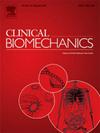Anterior and coracoid base tunnel location combined with single -or double clavicular tunnel techniques using double-button fixation for coracoclavicular ligament reconstruction both restore horizontal stability. A biomechanical cadaver study
IF 1.4
3区 医学
Q4 ENGINEERING, BIOMEDICAL
引用次数: 0
Abstract
Background
The placement of clavicle tunnels in coracoclavicular ligament reconstruction is well established, but the optimal position of the coracoid tunnel remains unclear. This study aimed to investigate how the coracoid tunnel's position affects horizontal stability during coracoclavicular ligament reconstruction using a double-button technique.
Methods
Fifteen fresh frozen shoulder cadaver specimens were tested under various conditions: intact coracoclavicular ligaments, disrupted ligaments, and reconstructions with a single coracoid and clavicle tunnel or double clavicle tunnels. The coracoid tunnel was positioned at the coracoid base 1/9, and 1/5 anterior to the base. Specimens underwent displacement-controlled loading, with 2D motion analysis conducted on captured digital images using TEMA motion analysis.
Findings
Mean displacement for intact coracoclavicular ligaments was 1.61 ± 0.92 mm, and 3.69 ± 1.09 mm for disrupted ligaments. For reconstructed conditions, displacements were as follows: Single-Tunnel Base (1.87 ± 0.64 mm), Single-Tunnel 1/9 (2.54 ± 1.13 mm), Single-Tunnel 1/5 (2.62 ± 1.17 mm), Double-Tunnel Base (1.25 ± 0.73 mm), Double-Tunnel 1/9 (2.03 ± 1.22 mm), and Double-Tunnel 1/5 (1.88 ± 1.20 mm). Differences among intact, reconstructed, and disrupted states were statistically significant (p = 0.01–0.0001), with all reconstruction techniques restoring horizontal displacement near the intact state.
Interpretation
At point zero both single coracoid tunnel and single- and double-clavicle tunnel restored horizontal displacement to its intact state. Coracoid tunnel placement anterior to the base of the coracoid did not influence horizontal displacement but single coracoid at the coracoid base and single clavicle tunnel resulted in the most anatomic reconstruction. Single coracoid tunnel at the base and double-clavicle resulted in the most stable reconstruction.
前方和冠状基底隧道位置结合使用双扣固定的单锁骨或双锁骨隧道技术进行锁骨韧带重建,都能恢复水平稳定性。一项尸体生物力学研究
背景锁骨隧道在锁骨韧带重建中的位置已得到公认,但冠状带隧道的最佳位置仍不明确。本研究旨在探讨在使用双扣技术进行角锁关节韧带重建时,锁骨隧道的位置如何影响水平稳定性。方法在不同条件下对 15 个新鲜冰冻肩部尸体标本进行了测试:完整的角锁关节韧带、中断的韧带、单锁骨和锁骨隧道或双锁骨隧道重建。肩胛骨隧道位于肩胛骨基部的 1/9,以及基部前方的 1/5。研究结果完整的锁骨韧带的平均位移为 1.61 ± 0.92 毫米,断裂的韧带的平均位移为 3.69 ± 1.09 毫米。重建条件下的位移如下:单隧道基底(1.87 ± 0.64 毫米)、单隧道 1/9(2.54 ± 1.13 毫米)、单隧道 1/5(2.62 ± 1.17 毫米)、双隧道基底(1.25 ± 0.73 毫米)、双隧道 1/9(2.03 ± 1.22 毫米)和双隧道 1/5(1.88 ± 1.20 毫米)。完整状态、重建状态和中断状态之间的差异具有统计学意义(p = 0.01-0.0001),所有重建技术都能将水平位移恢复到接近完整状态。将肩胛骨隧道放置在肩胛骨基部前方不会影响水平位移,但在肩胛骨基部放置单肩胛骨隧道和单锁骨隧道可实现最符合解剖学的重建。位于基部的单冠状突隧道和双锁骨重建最为稳定。
本文章由计算机程序翻译,如有差异,请以英文原文为准。
求助全文
约1分钟内获得全文
求助全文
来源期刊

Clinical Biomechanics
医学-工程:生物医学
CiteScore
3.30
自引率
5.60%
发文量
189
审稿时长
12.3 weeks
期刊介绍:
Clinical Biomechanics is an international multidisciplinary journal of biomechanics with a focus on medical and clinical applications of new knowledge in the field.
The science of biomechanics helps explain the causes of cell, tissue, organ and body system disorders, and supports clinicians in the diagnosis, prognosis and evaluation of treatment methods and technologies. Clinical Biomechanics aims to strengthen the links between laboratory and clinic by publishing cutting-edge biomechanics research which helps to explain the causes of injury and disease, and which provides evidence contributing to improved clinical management.
A rigorous peer review system is employed and every attempt is made to process and publish top-quality papers promptly.
Clinical Biomechanics explores all facets of body system, organ, tissue and cell biomechanics, with an emphasis on medical and clinical applications of the basic science aspects. The role of basic science is therefore recognized in a medical or clinical context. The readership of the journal closely reflects its multi-disciplinary contents, being a balance of scientists, engineers and clinicians.
The contents are in the form of research papers, brief reports, review papers and correspondence, whilst special interest issues and supplements are published from time to time.
Disciplines covered include biomechanics and mechanobiology at all scales, bioengineering and use of tissue engineering and biomaterials for clinical applications, biophysics, as well as biomechanical aspects of medical robotics, ergonomics, physical and occupational therapeutics and rehabilitation.
 求助内容:
求助内容: 应助结果提醒方式:
应助结果提醒方式:


